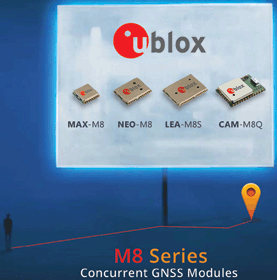

u-blox has rolled out a new range of standalone positioning modules based on its cutting-edge M8 and u-blox 7 GNSS (global navigation satellite system) technologies.
The resulting EVA, MAX, NEO, LEA and PAM modules are based on the company’s industry proven form factors to deliver fast, accurate and reliable positioning with low power consumption.
The MAX-M8 series of standalone concurrent GNSS modules, with a dual-frequency RF front-end, feature a positioning engine which is able to intelligently use the highest amount of visible satellites from two GNSS (GPS, GLONASS and BeiDOU) systems for more reliable positioning.
The MAX-M8 series provides high sensitivity and minimal acquisition times while maintaining low system power. The MAX-M8C is optimised for cost-sensitive applications, while the MAX-M8Q/W provides best performance and easier RF integration.
The LEA-M8S module delivers concurrent GNSS location capability together with high-performance u-blox M8 positioning technology in the LEA form factor. As with the MAX-M8, it features a dual-frequency RF front-end and can take advantage of GPS, GLONASS and BeiDou satellite constellations.
The NEO-M8 series supports GPS, GLONASS, Galileo, BeiDou, QZSS and SBAS, and provides high sensitivity and minimal acquisition times while maintaining low system power. The NEO-M8M/Q is optimised for cost-sensitive applications, while the NEO-M8N provides best performance and easier RF integration.
The PAM-7Q patch antenna module is straightforward to integrate into designs thanks to its embedded antenna, low power consumption, simple interface and sophisticated interference suppression that ensures maximum performance even in GPS-hostile environments. The 18 x 18 mm patch antenna provides RHCP polarisation, which is not achievable with smaller patch antenna elements. The simple design and easy interfacing keeps installation costs to a minimum.
The CAM-M8Q chip antenna module, featuring a multi-GNSS (GPS/QZSS, GLONASS and BeiDou) engine, delivers high sensitivity and minimal acquisition times in an ultra compact form factor. As with the PAM-7Q, integration is simple with its embedded GNSS antenna, low power consumption, small footprint of 9,6 x 14 x 1,95 mm, and sophisticated interference suppression in GNSS-hostile environments.
For more information contact Andrew Hutton, RF Design, +27 (0)21 555 8400, [email protected], www.rfdesign.co.za
| Tel: | +27 21 555 8400 |
| Email: | [email protected] |
| www: | www.rfdesign.co.za |
| Articles: | More information and articles about RF Design |

© Technews Publishing (Pty) Ltd | All Rights Reserved